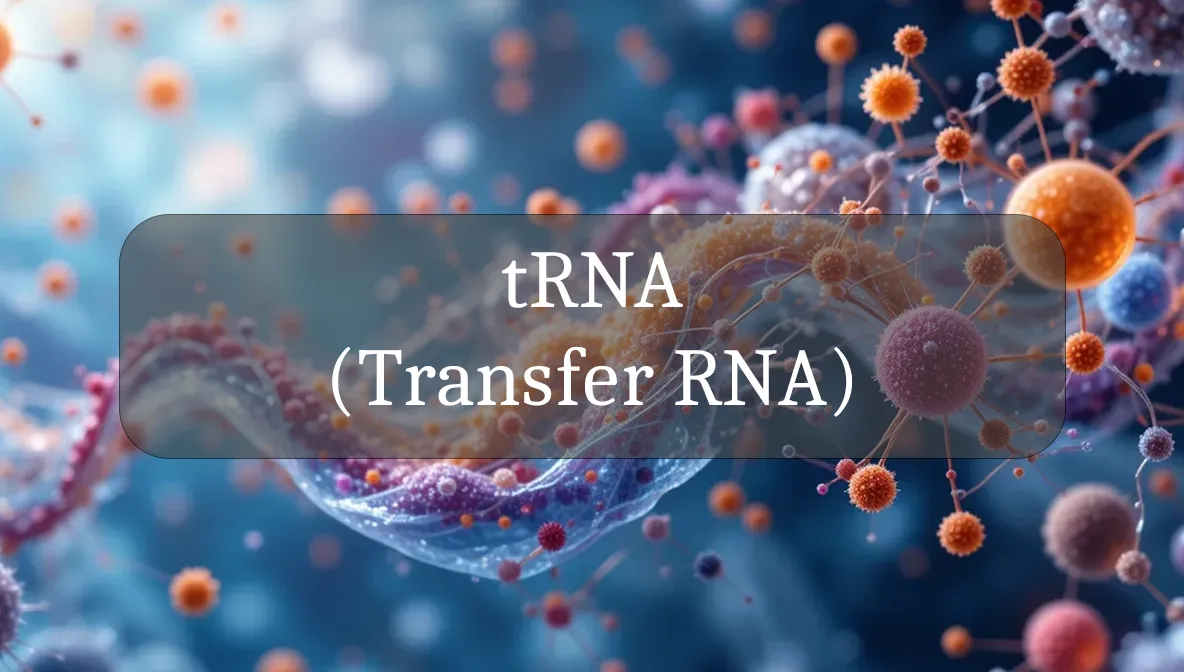Protein-Building Couriers of Your Cells
Transfer RNA, or tRNA, might sound like a science lab term, but it’s really a group of tiny molecules in your cells that act like delivery workers, shuttling the right building blocks to create proteins that keep you strong and energized. These little couriers are essential for everything from muscle repair to immune defense. For health-conscious folks, understanding tRNA can inspire choices that boost your cellular health and long-term vitality. Let’s explore what tRNA is, why it matters, and how you can support it for daily wellness!
Chemical Identity and Type
Transfer RNA (tRNA) is a small RNA molecule, typically 70–90 nucleotides long, shaped like a cloverleaf. It’s found in the cytoplasm of your cells, where it works in ribosomes—the cell’s protein-making factories. tRNA’s job is to “read” the instructions from messenger RNA (mRNA) and deliver specific amino acids, the building blocks of proteins, to the right spot. Think of tRNA as a courier who picks up the exact ingredients needed to assemble proteins according to your DNA’s recipe.
Biological Role and Benefits
tRNA is a key player in your body’s health and resilience:
- Protein Production: tRNA ensures amino acids are added in the right order to build proteins for muscle growth, tissue repair, and enzyme function.
- Immune Support: It helps create immune proteins, like antibodies, that fight germs and keep you healthy.
- Energy and Metabolism: tRNA supports the production of proteins that regulate energy and nutrient use, keeping you energized.
- Cell Repair: It aids in building proteins for healing tissues, like skin or muscles, after injury or exercise.
- Overall Vitality: By enabling accurate protein synthesis, tRNA supports every process that keeps your body strong and balanced.
Healthy tRNA function means your cells can build the proteins needed to thrive, boosting your strength, immunity, and energy.
Dietary or Natural Sources
You don’t get tRNA from food—it’s made naturally by your cells. But you can support tRNA production and function with these nutrient-rich choices:
- Protein-Rich Foods: Eggs, fish, beans, and lean meats provide amino acids, the raw materials tRNA delivers for protein synthesis.
- Antioxidant-Rich Foods: Berries, leafy greens, and nuts (high in vitamins C and E) protect cells and tRNA from damage.
- B-Vitamin Foods: Whole grains, spinach, and lentils supply folate and B6, which support RNA and protein processes.
- Magnesium-Rich Foods: Nuts, seeds, and dark chocolate provide magnesium, which helps ribosomes and tRNA work efficiently.
A balanced diet creates a cell-friendly environment for tRNA to do its job.
Signs of Imbalance or Dysfunction
tRNA dysfunction is hard to detect directly, but issues with protein production may show up as:
- Fatigue: Low energy due to disrupted protein synthesis for energy or repair.
- Weak Immunity: Frequent infections or slow recovery, as tRNA supports immune protein production.
- Slow Healing: Wounds or muscles taking longer to recover due to faulty protein synthesis.
- Muscle Weakness: Difficulty building or maintaining muscle strength.
- Brain Fog: Trouble with focus or mood, as tRNA aids proteins for brain function.
These symptoms can have many causes, so if they persist, consult a healthcare provider to explore cell health or other issues.
Supporting Optimal Levels or Function
To keep your tRNA working well, try these evidence-based tips:
- Eat a Balanced Diet: Include lean proteins, colorful fruits, and whole grains to provide amino acids and nutrients for tRNA function.
- Exercise Regularly: Strength training or moderate activities like walking or yoga boost protein synthesis and tRNA activity.
- Prioritize Sleep: Aim for 7–9 hours of quality sleep to allow cells to repair and maintain RNA processes.
- Manage Stress: Meditation, deep breathing, or journaling can lower stress hormones that disrupt tRNA function.
- Limit Toxins: Avoid smoking, excessive alcohol, or processed foods, which can harm cells and RNA.
Small, consistent habits support tRNA and keep your protein-building couriers thriving.
Safety, Interactions, and Precautions
tRNA is a natural part of your cells and safe, but certain factors can disrupt its function:
- Oxidative Stress: Too many free radicals (from poor diet or pollution) can damage tRNA. Eat antioxidant-rich foods to counter this.
- Chronic Stress: High cortisol levels may interfere with tRNA’s role in protein synthesis. Practice daily stress relief.
- Environmental Toxins: Pollutants or UV exposure can harm cells and RNA. Use sunscreen and choose organic produce when possible.
- Medications: Some drugs, like certain antibiotics or chemotherapy agents, may affect tRNA or ribosome function. Discuss medications with your doctor.
Protecting tRNA means minimizing these stressors and prioritizing cell-friendly habits.
Fun Fact
Did you know tRNA’s cloverleaf shape is like a tiny origami masterpiece? Its unique structure lets it grab the right amino acid and deliver it with pinpoint accuracy to build proteins perfectly every time!
Citations
- National Institutes of Health (NIH): Transfer RNA and Protein Synthesis.
- Mayo Clinic: Protein Synthesis and Cellular Health.
- Cleveland Clinic: Nutrition and Cell Function.
- World Health Organization (WHO): Diet and Chronic Disease Prevention.
- USDA: Dietary Guidelines for Americans – Nutrient-Dense Diets.

